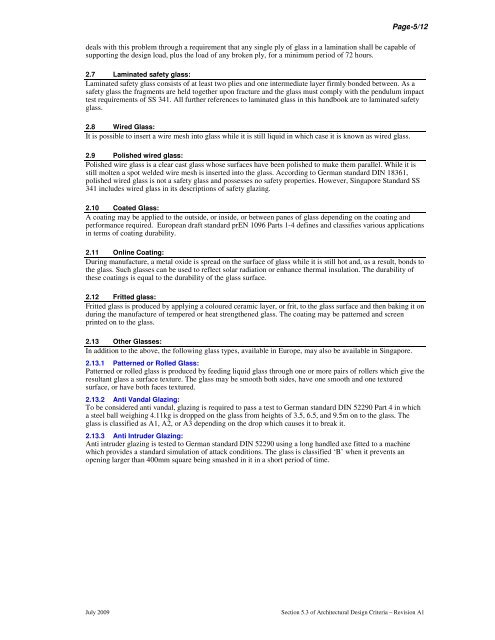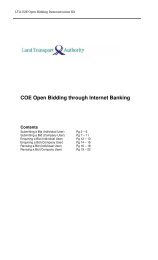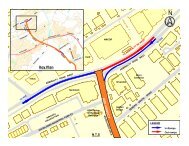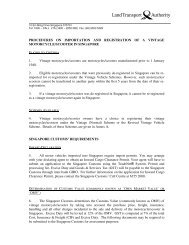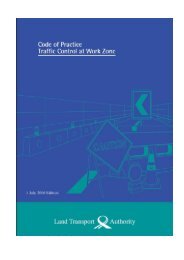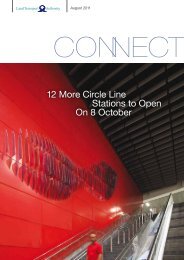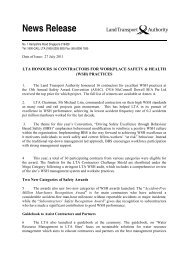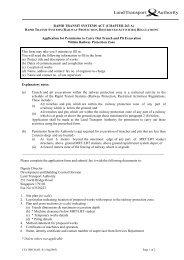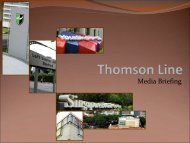ADC Section 5 - Support Design Guidelines - Land Transport Authority
ADC Section 5 - Support Design Guidelines - Land Transport Authority
ADC Section 5 - Support Design Guidelines - Land Transport Authority
- No tags were found...
Create successful ePaper yourself
Turn your PDF publications into a flip-book with our unique Google optimized e-Paper software.
Page-5/12deals with this problem through a requirement that any single ply of glass in a lamination shall be capable ofsupporting the design load, plus the load of any broken ply, for a minimum period of 72 hours.2.7 Laminated safety glass:Laminated safety glass consists of at least two plies and one intermediate layer firmly bonded between. As asafety glass the fragments are held together upon fracture and the glass must comply with the pendulum impacttest requirements of SS 341. All further references to laminated glass in this handbook are to laminated safetyglass.2.8 Wired Glass:It is possible to insert a wire mesh into glass while it is still liquid in which case it is known as wired glass.2.9 Polished wired glass:Polished wire glass is a clear cast glass whose surfaces have been polished to make them parallel. While it isstill molten a spot welded wire mesh is inserted into the glass. According to German standard DIN 18361,polished wired glass is not a safety glass and possesses no safety properties. However, Singapore Standard SS341 includes wired glass in its descriptions of safety glazing.2.10 Coated Glass:A coating may be applied to the outside, or inside, or between panes of glass depending on the coating andperformance required. European draft standard prEN 1096 Parts 1-4 defines and classifies various applicationsin terms of coating durability.2.11 Online Coating:During manufacture, a metal oxide is spread on the surface of glass while it is still hot and, as a result, bonds tothe glass. Such glasses can be used to reflect solar radiation or enhance thermal insulation. The durability ofthese coatings is equal to the durability of the glass surface.2.12 Fritted glass:Fritted glass is produced by applying a coloured ceramic layer, or frit, to the glass surface and then baking it onduring the manufacture of tempered or heat strengthened glass. The coating may be patterned and screenprinted on to the glass.2.13 Other Glasses:In addition to the above, the following glass types, available in Europe, may also be available in Singapore.2.13.1 Patterned or Rolled Glass:Patterned or rolled glass is produced by feeding liquid glass through one or more pairs of rollers which give theresultant glass a surface texture. The glass may be smooth both sides, have one smooth and one texturedsurface, or have both faces textured.2.13.2 Anti Vandal Glazing:To be considered anti vandal, glazing is required to pass a test to German standard DIN 52290 Part 4 in whicha steel ball weighing 4.11kg is dropped on the glass from heights of 3.5, 6.5, and 9.5m on to the glass. Theglass is classified as A1, A2, or A3 depending on the drop which causes it to break it.2.13.3 Anti Intruder Glazing:Anti intruder glazing is tested to German standard DIN 52290 using a long handled axe fitted to a machinewhich provides a standard simulation of attack conditions. The glass is classified ‘B’ when it prevents anopening larger than 400mm square being smashed in it in a short period of time.July 2009<strong>Section</strong> 5.3 of Architectural <strong>Design</strong> Criteria – Revision A1


